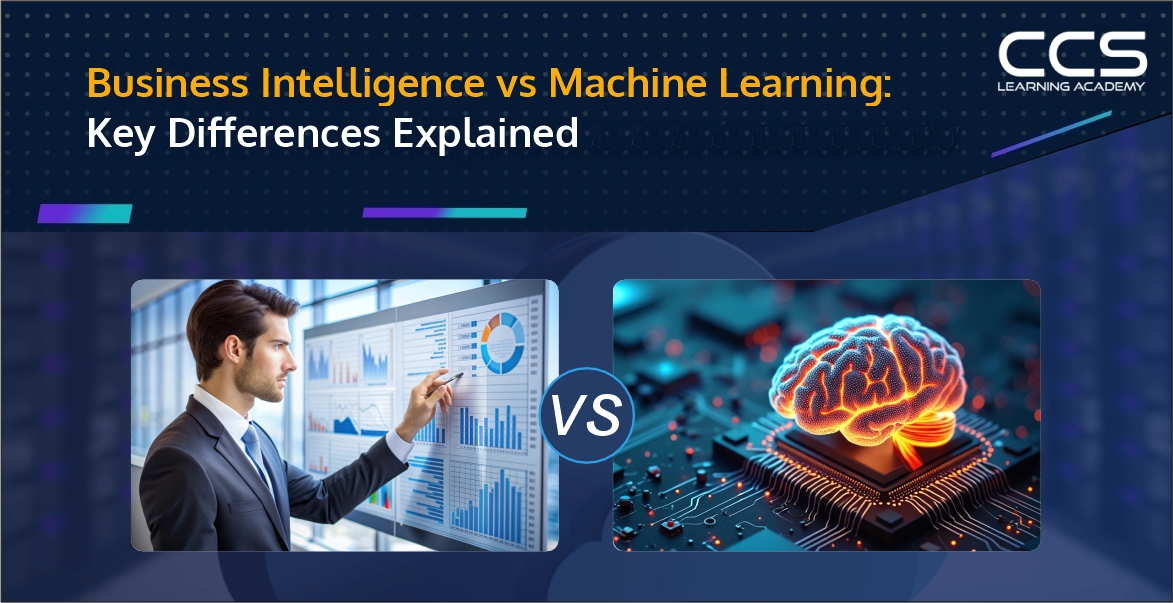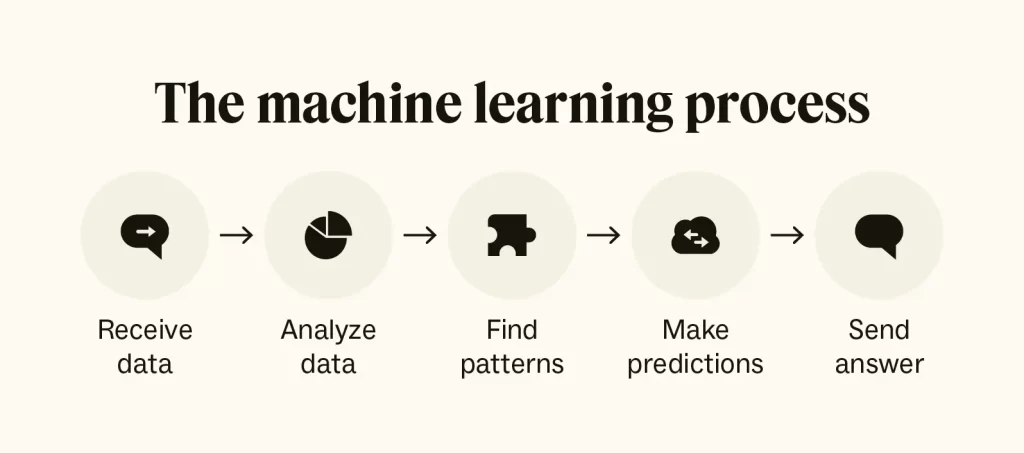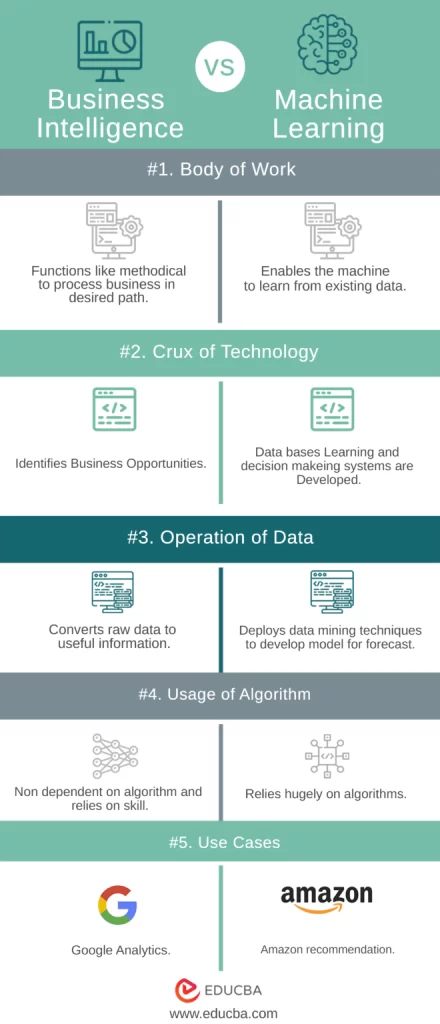Business Intelligence vs Machine Learning: Key Differences Explained
- -
- Time -

Business intelligence (BI) and machine learning (ML) are two powerful data-driven technologies that are transforming how businesses operate and make decisions. However, there are some key differences between these approaches that businesses need to understand to determine the best strategy.
The global market for machine learning is projected to reach US$79.29 billion by 2024, with an impressive annual growth rate (CAGR 2024-2030) of 36.08%. This rapid growth is expected to drive the market volume to US$503.40 billion by 2030, reflecting the increasing adoption and integration of ML technologies across various industries.
This article explores the core differences between business intelligence and machine learning in terms of their objectives, approaches, outputs, data requirements, use cases, users, and enabling tools. It also looks at how ML can enhance the capabilities of traditional BI systems.
Let’s start by understanding the fundamentals of each technology.
Table of Contents
- What is Business Intelligence?
- Key Advantages of BI
- Disadvantages of BI
- Common BI Use Cases
- What is Machine Learning?
- Key Advantages of Machine Learning
- Disadvantages of Machine Learning
- Common Use Cases of Machine Learning
- Typical Machine Learning users and popular tools
- Business Intelligence vs Machine Learning: Comparison Table
- Key Differences Between Business Intelligence and Machine Learning
- Augmenting BI with ML
- Using AWS for a Seamless BI-ML Integration
- Conclusion
- FAQs
What is Business Intelligence?
Business intelligence (BI) refers to technologies, applications and practices for the collection, integration, analysis and presentation of business data. The goal of BI is to support better business decision-making. Essentially, BI systems are data-driven decision support systems (DSS).
Business intelligence is sometimes used interchangeably with terms like reporting tools, dashboards, reports and query tools, and enterprise information systems. BI systems provide historical, current and predictive insights into business operations, often using data that has been consolidated into a data warehouse or data mart and sometimes working directly from operational data.
Key Advantages of BI
Key advantages of BI include:
Identifying trends and patterns in data
BI helps identify trends and patterns in business data. This can lead to more informed decisions. By analyzing sales, customer or operational metrics over time, patterns can be spotted. Understanding trends in the past can guide decisions for the future.
Enabling real-time reporting
BI allows for real-time reporting of business metrics. Dashboards can be created to monitor key performance indicators on an ongoing basis. This helps businesses respond quickly to changing market conditions or operational issues. Real-time insights mean opportunities or problems can be addressed immediately.
Allowing analysis of business performance
BI provides the ability to analyze historical business performance across many important metrics like revenues, costs, customer retention and more. Bottlenecks and underperforming areas can be identified. This helps businesses understand what is working well and where there may be room for improvement. Better decisions can be made to boost overall performance.
Disadvantages of BI
Some disadvantages are:
Reliance on historical data
While BI offers insights into past performance, it is limited by relying only on historical data. Past trends may not necessarily continue into the future. External factors could impact future business trends in unpredictable ways.
Limited to internal organizational data
BI is restricted to insights from a company’s own internal data sources. It does not factor in external market conditions or competitor intelligence which could also drive business outcomes. Relying solely on internal data limits strategic perspective.
Requirement of extensive data preparation
BI requires significant effort to collect relevant data from different operational systems, clean it and structure it appropriately in a data warehouse. This lengthy data preparation process is needed before any analysis can begin. It increases the time taken before insights are available.
Common BI Use Cases
Common BI use cases include:
Sales forecasting
BI helps predict likely sales volumes based on past sales performance, trends, seasonal patterns and other influencing factors. Forecasts guide production planning, inventory management and other strategic decisions.
Financial analysis
Metrics like revenues, costs, profits, expenses etc. can be analyzed to monitor financial health and performance. Deviations from budgets or targets can be spotted early.
Customer segmentation
Patterns in customer profile attributes and behavior can be identified to segment customers. This helps tailor products and services according to each segment’s unique needs.
Performance analysis
KPIs related to production output, employee productivity, customer satisfaction or other metrics can be monitored. Underperforming areas can be pinpointed for improvement actions.
Typical BI Users and Popular Tools
Roles like business analysts produce reports and insights while executives and managers use BI to guide strategic decisions and monitor business performance.
Popular BI tools include Tableau, Qlik, Microsoft Power BI and IBM Cognos. These provide functionalities for data visualization, ad-hoc analysis, interactive reporting and dashboards.
What is Machine Learning?

Machine learning (ML) refers to the practice of using algorithms to parse data, learn from it, and make predictions without being explicitly programmed. The core idea is that machines or systems can learn from data, identify patterns and make decisions with minimal human input after some initial programming/training.
Key Advantages of Machine Learning
Some key advantages of machine learning include:
Automation of Complex Analysis and Predictive Tasks
One of the major advantages of machine learning is its ability to automate complex analysis and predictive tasks. Machine learning algorithms can analyze huge volumes of data and discover patterns to make accurate predictions. This automation frees up human experts to focus on more strategic work.
Ability to Self-Learn from New Data Continuously
Machine learning systems are able to continuously learn from new data. As more and more data is fed into a machine learning model, it becomes more accurate at making predictions. This self-learning capability allows machine learning models to stay up-to-date without requiring re-programming.
Discovery of Hidden Patterns that Humans May Miss
Machine learning excels at discovering complex patterns and relationships in large, multidimensional datasets. This allows machine learning models to uncover hidden insights that may be difficult for humans to find even when looking at the same data.
Adaptability to Changing Environments and Scenarios
Well-trained machine learning models can adapt intelligently to new scenarios and changing environments. As they learn from new data, machine learning systems gain the ability to generalize beyond their original use cases, making them very versatile.
Disadvantages of Machine Learning
Some disadvantages are:
Dependency on Vast Amounts of Quality Data for Training
Machine learning algorithms require huge volumes of high-quality, labeled training data to learn from. The effectiveness of a machine learning model depends considerably on the volume and nature of the data used to train it.
Models Require Constant Retraining as More Data Becomes Available
As more and more relevant data becomes available over time, machine learning models need to be retrained on the new, expanded dataset. This requires constant monitoring and retraining efforts as data volumes grow.
Results Can Be Unpredictable Due to Complex Relationships in Data
Machine learning discovers complex, multidimensional relationships in data during training. This makes it difficult to fully understand and explain the reasoning behind a machine learning model’s predictions. Results may vary in unpredictable ways.
Common Use Cases of Machine Learning
Some common applications of machine learning include predictive maintenance, fraud detection, risk analysis, targeted recommendations, translation services and computer vision applications.
Machine learning powers applications that automate complex pattern recognition, decision making and prediction tasks.
Typical Machine Learning users and popular tools
Typical machine learning practitioners and users include data scientists, developers and engineers. Data scientists build and train machine learning models while developers and engineers integrate trained ML models into applications and services.
Popular ML frameworks used by these practitioners include TensorFlow, PyTorch, scikit-learn, OpenCV and Keras.
Business Intelligence vs Machine Learning: Comparison Table
This table summarizes the key differences between Business Intelligence and Machine Learning, highlighting their unique characteristics and applications.
| Aspect | Business Intelligence (BI) | Machine Learning (ML) |
|---|---|---|
| Objective | Analyze past and current data to identify trends and improve decision-making | Build predictive models to automate decisions and forecasts about future outcomes |
| Approach | Manual analysis using rules and human intervention to extract insights from structured data | Algorithmic learning from large volumes of structured and unstructured data with minimal human involvement |
| Outputs | Reports, visualizations, dashboards, scorecards | Algorithms, predictive models, machine-driven recommendations |
| Data Requirements | Structured historical data from internal sources | Large volumes of structured, unstructured, and real-time data from various sources |
| Users | Business analysts, executives, managers | Data scientists, engineers, developers |
| Tools | Tableau, Power BI, Qlik, MicroStrategy | TensorFlow, PyTorch, scikit-learn, Keras, Apache Spark MLlib |
| Speed | Periodic reporting, may not reflect real-time changes | Real-time insights as new data arrives |
| Scalability | Limited by human analysis capacities; may struggle with large, complex datasets | Scales to analyze massive datasets and derive insights from large volumes of data |
| Complexity | Provides insights based on simpler data relationships | Uncovers complex patterns and relationships in multidimensional datasets |
| Human Oversight | Requires ongoing human analysis and preparation of reports | Operates autonomously after training; requires less ongoing human oversight |
| Costs and Resources | Requires manual effort for data preparation and analysis; less initial cost but more ongoing effort | Higher initial costs for data preparation and specialized tools; can lead to reduced manual effort and increased productivity |
Key Differences Between Business Intelligence and Machine Learning

Now that we understand the basic concepts, let’s explore some of the core differences between BI and ML:
Objectives
The main objective of BI is to analyze past and current data to identify trends and patterns that can enhance business operations and decision making. The goal of ML, on the other hand, is to build predictive models that leverage patterns in historical data to drive automated decisions and forecasts about potential future outcomes.
Approach
BI takes a more manual approach, relying on rules and human data analysis to gain insights from structured data sources. ML employs algorithms, statistics and probability to learn from large volumes of structured and unstructured data with minimal human involvement.
Outputs
BI focuses on generating reports, visualizations, dashboards and scorecards to communicate findings to users. ML creates algorithms, predictive models and machine-driven recommendations/outputs.
Data Requirements
BI typically uses structured historical data from databases and internal sources. ML requires large volumes of structured, unstructured and real-time data from multiple internal and external sources for training complex algorithms and models.
Examples
Common BI use cases include sales forecasting, customer analysis and financial reporting. Example ML applications are predictive maintenance, fraud detection, sentiment analysis and product recommendations.
Users
The primary users of BI systems are business analysts, executives and managers interpreting results. Machine learning tools are operated by data scientists, engineers and developers building models.
Tools
Popular BI platforms are Tableau, Power BI, Qlik and MicroStrategy. Common ML frameworks include TensorFlow, PyTorch, scikit-learn, Keras and Apache Spark MLlib.
Additional Considerations
Beyond these core differences, there are some additional factors to keep in mind when comparing BI and ML:
Speed
Once machine learning models have been trained on historical data, they can deliver insights in real-time as new data arrives. This is significantly faster than traditional business intelligence processes which rely on periodic reporting as data is manually analyzed. ML enables organizations to continuously gain insights and make decisions at the speed of business.
Scalability
Machine learning easily scales to analyze massive and diverse datasets with millions or even billions of data points. As data volumes continue growing, ML is better equipped to draw meaningful insights. On the other hand, business intelligence is limited by human analysis capacities and can struggle to glean insights from large and complex datasets.
Complexity
Advanced machine learning algorithms like deep learning are capable of uncovering highly complex patterns and interrelationships in large datasets. They can find insights that would be difficult or impossible for humans to deduce manually. This enables ML to provide a more comprehensive view of phenomena like customer behavior.
Human Oversight
Once properly trained, machine learning models generally operate autonomously with little ongoing human oversight. They continuously analyze new data and refine their outputs. In contrast, business intelligence initiatives require dedicated human analysts to regularly prepare reports and uncover fresh insights.
Costs and Resources
The initial deployment of machine learning solutions demands greater resources for data cleaning, engineering skills, specialized tools and infrastructure. However, these costs can pay off quickly by automating routine tasks and delivering actionable insights at scale. With ML, organizations also need fewer business analysts over time.
Augmenting BI with ML
While distinct, BI and ML can also be complementary and work together seamlessly within organizations. ML can enhance traditional BI systems in powerful ways:
Discover hidden insights
Machine learning algorithms have the unique ability to analyze vast amounts of data and discover intricate patterns that may not be obvious to humans. When applied to the large data warehouses used for business intelligence, ML can uncover deeper insights that were previously hidden. By training algorithms on the historical data stored in a company’s BI system, patterns may emerge that human analysts did not detect through typical reporting and visualization.
For example, an ML model could find that customers who make purchases on a certain day of the week are more likely to complete additional purchases within the next month. Such a subtle trend would be nearly impossible for humans to manually identify but could provide important strategic guidance when uncovered. ML vastly increases the discoverable insights within existing BI data stores.
Improved forecasting accuracy
Traditional forecasting methods in BI often rely on simple statistical projections based on historical patterns. While useful as a starting point, these approaches have limitations and the forecasts may not reflect changing market conditions or disruptions. ML predictive models using the same store of historical BI data as input can generate more accurate forecasts, projections, and simulations of potential scenarios.
By recognizing complex patterns in past sales, customer behavior, product performance and other factors, ML forecasts are able to more precisely predict how those interrelated elements may change and impact the future. This improves planning, resource allocation, budgeting and risk assessment for organizations as they can trust the improved accuracy of ML-driven BI forecasts.
Automated tasks and processes
Routine maintenance and processing of large volumes of BI data can involve much manual effort from analysts and reports authors. Complex generation of period-over-period comparison reports, aggregating metrics from different sources, data preparation for advanced analysis, and other repetitive tasks consume significant resources.
ML automation can help reduce such tasks by programatically completing standard procedures according to predefined models. This frees valuable analyst time to focus on more strategic interpretation of insights, exploration of undiscovered patterns and development of new BI applications and visualizations. Automating mundane aspects of BI management with ML optimization leads to higher productivity.
Real-time decision making
Static reports generated on a schedule are often outdated shortly after delivery, failing to reflect rapid changes in real-world conditions. To facilitate nimble, data-driven decisions, BI must operate in real-time. ML integrated with operational data systems powering dynamic online BI analytics dashboards and interfaces provides up-to-the-minute insights.
Decision makers can take prompt action informed by the latest available information. For example, ML-based recommendations or alerts could guide immediate promotion or repricing decisions based on ongoing sales or inventory levels. Such real-time ML-enhanced BI is increasingly crucial for competitive responsiveness in fast-moving industries.
Enhanced customer understanding
Traditional customer profiling, segmentation, predictive modeling and lifetime value analyses in BI derive highly useful knowledge. However, ML techniques can further refine customer intelligence by detecting minute nuances and change indicators across more diverse data sources.
Combining ML and BI allows a more rounded understanding of individual customers along with high-level segments. Advanced ML algorithms can derive insight from broad datasets encompassing transaction records, website usage, emails, surveys, call center notes and even social media or mobile location data. This drives hyper-personalization helpful for optimizing the customer experience at scale through BI-guided operationalization.
Using AWS for a Seamless BI-ML Integration
Amazon Web Services (AWS) is a leading platform for implementing both BI and ML projects at scale. AWS offers fully-managed services across every layer of data infrastructure including databases, analytics, machine learning, compute, storage and visualization.
Pre-built AWS services like Amazon Redshift, Athens, QuickSight, SageMaker, EMR and Lambda provide a seamless experience for building BI data warehouses, deploying ML models, and operationalizing BI and ML workloads together. Infrastructure automation through AWS Cloud formation also eliminates manual effort.
Overall, AWS simplifies and optimizes the end-to-end workflow from data ingestion and storage, to modeling, deployment and consumption of real-time BI and ML insights across the organization on any device.
Conclusion
In conclusion, while both business intelligence and machine learning rely on analyzing data to produce actionable insights, they differ significantly in their scope, methodologies and goals. BI focuses on monitoring and enhancing past business performance through structured reporting and manual analysis. Machine learning emphasizes developing self-learning algorithms and models that can autonomously predict outcomes and drive optimized future decisions.
The choice between BI and ML depends on an organization’s specific needs, datasets, skills and resources. However, leveraging their complementary strengths offers immense opportunities to elevate data-driven decision making to new levels. With AWS at their core, enterprises can seamlessly integrate BI data infrastructure with ML workflows to discover hidden business opportunities.
CCS Learning Academy’s Data Analytics and Business Intelligence courses provide the foundational knowledge and skills needed to excel in BI. Whether you’re new to BI or looking to enhance your expertise, our courses will equip you with the tools to transform data into actionable insights. Enroll today to elevate your career and become a leader in data-driven strategy.
FAQs
Business Intelligence (BI) aims to provide actionable insights from data through querying, reporting, and visual analytics to support better business decision-making. Machine Learning (ML), on the other hand, focuses on developing algorithms that allow computers to learn from and make predictions based on data, often autonomously.
BI is commonly used for performance metrics and reports, operational reporting, and providing dashboards to business users for better understanding past and present business performance. It’s instrumental in areas like financial forecasting, customer behavior analysis, and operational efficiency.
ML applications range from predictive analytics, such as forecasting demand or detecting potential fraud, to more advanced uses like image recognition, natural language processing, and autonomous systems (e.g., self-driving cars). ML is extensively used to uncover patterns and insights within data that are not readily apparent.
BI typically uses structured data from relational databases and is primarily descriptive, focusing on generating reports and dashboards based on historical data. ML uses both structured and unstructured data, employing algorithms to predict future outcomes and to generate models that adapt based on new data.
BI professionals typically need skills in data querying (SQL), data warehousing, and visualization tools like Tableau or Power BI. They also need a good understanding of business processes and data interpretation. ML professionals require a strong background in statistics, programming (Python, R), and a deep understanding of ML algorithms and data modeling techniques.
Yes, integrating BI and ML can be highly beneficial. BI can help identify trends and areas of interest that can be further explored using ML to predict and automate decisions. Conversely, insights and predictive models from ML can enhance BI dashboards and reports with forward-looking capabilities, making the analytics more dynamic.
ML is generally more complex to implement than BI because it involves not only handling large volumes of data from various sources but also requires building and training models that can accurately predict outcomes. BI implementations can be complex too but are typically less technically demanding than ML projects.
Both BI and ML need to consider scalability, but the challenges can differ. BI needs to handle large volumes of data efficiently and deliver insights in a timely manner, often in real-time. ML needs to not only handle large data sets but also scale in terms of computational power to train models efficiently.
BI directly supports business strategy by providing clear insights into the business operations and outcomes, aiding tactical decision-making. ML influences strategy by predicting trends and behaviors, providing a basis for more strategic, data-driven decisions that anticipate future conditions.
Future trends in BI include more advanced real-time analytics, augmented analytics using AI to enhance data discovery and insights, and greater integration with collaborative tools. In ML, trends point towards increased automation (AutoML), better interpretability of models, and broader integration of AI across industries.






